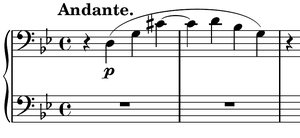
Nuages Gris
Encyclopedia

Piano
The piano is a musical instrument played by means of a keyboard. It is one of the most popular instruments in the world. Widely used in classical and jazz music for solo performances, ensemble use, chamber music and accompaniment, the piano is also very popular as an aid to composing and rehearsal...
solo composed by Franz Liszt
Franz Liszt
Franz Liszt ; ), was a 19th-century Hungarian composer, pianist, conductor, and teacher.Liszt became renowned in Europe during the nineteenth century for his virtuosic skill as a pianist. He was said by his contemporaries to have been the most technically advanced pianist of his age...
on August 24, 1881. It is one of Liszt's most haunting and at the same time one of his most experimental works, representing, according to Allen Forte
Allen Forte
Allen Forte is a music theorist and musicologist. He was born in Portland, Oregon and fought in the Navy at the close of World War II before moving to the East Coast. He is now Battell Professor of Music, Emeritus at Yale University...
, "a high point in the experimental idiom with respect to expressive compositional procedure."' If we must look for biographical parallels with the music, perhaps the bleakness of mood is connected with difficulties faced by Liszt at the time of composition, when he was suffering from dropsy
Edema
Edema or oedema ; both words from the Greek , oídēma "swelling"), formerly known as dropsy or hydropsy, is an abnormal accumulation of fluid beneath the skin or in one or more cavities of the body that produces swelling...
, failing eyesight, and severe injuries sustained in a fall down the stairs of the Hofgiirtnerei seven weeks earlier.
Departing from his earlier virtuoso style, Liszt in his later years made several radical, compositional experiments, including Nuages gris, Unstern S.208 and Bagatelle sans tonalité S.216. Yet it was only in the second half of the twentieth century that the significance of Liszt's late experimental works began to be appreciated. R. Larry Todd, for example, has noted that "Arguably, Liszt was the first composer to establish the augmented triad as a truly independent sonority, to consider its implications for modem dissonance treatment, and to ponder its meaning for the future course of tonality. Liszt's accomplishments in these areas were considerable and support in no small way his position, in Busoni's phrase, as the 'master of freedom.' Scholars such as Humphrey Searle, Zoltán Harsányi
Zoltán Harsányi
Zoltán Harsányi is a Slovak of Hungarian ethnic origin, footballer currently at Dunajská Streda, who previously played for Bolton Wanderers in the Premier League.-Club career:...
, Bence Szabolcsi, Lajos Bárdos
Lajos Bárdos
Lajos Bárdos was a composer, conductor, and professor of music at the Franz Liszt Academy of Music. Together with Zoltán Kodály, he laid the foundations of 20th-century Hungarian choral music...
, and István Szelényi have contributed much to placing these works in the repertoire of today's pianists.
Nuages gris is quite short and technically simple. According to Jim Samson, "the most distinctive features of Liszt's late style are present in this short work—the avoidance of a conventional cadential structure, the importance of semitonal movement, the use of the augmented triad as the central harmonic unit and of parallelism as a principal means of progression." The harmonies are based on augmented triads while the melody line makes extensive reference to the G lydian mode. The harmonies, which are very different from those found in his earlier works, give a very dark and almost morbid feel to the piece. Leonard Ratner has commented: "The restless, unresolved dissonances of Nuages gris the isolated figures, the sense of alienation—these have a clear affinity with the somewhat later expressionism of the Viennese composers Mahler and Schoenberg.... [Nuages gris] is a musical bellwether that indicated what was happening and what would happen in European music: sound, with the assistance of symmetry, would take over, harmony would be absorbed into color and lose its cadential function."
Claude Debussy
Claude Debussy
Claude-Achille Debussy was a French composer. Along with Maurice Ravel, he was one of the most prominent figures working within the field of impressionist music, though he himself intensely disliked the term when applied to his compositions...
probably had Nuages gris in mind when he composed his own Nuages.
Mauricio Kagel
Mauricio Kagel
Mauricio Kagel was a German-Argentine composer. He was notable for his interest in developing the theatrical side of musical performance .-Biography:...
used Nuages gris in his Unguis incarnatus est (1972). A shocking scene at the morgue in Stanley Kubrick
Stanley Kubrick
Stanley Kubrick was an American film director, writer, producer, and photographer who lived in England during most of the last four decades of his career...
's last film Eyes Wide Shut
Eyes Wide Shut
Eyes Wide Shut is a 1999 drama film based upon Arthur Schnitzler's 1926 novella Traumnovelle . The film was directed, produced and co-written by Stanley Kubrick, and was his last film. The story, set in and around New York City, follows the sexually-charged adventures of Dr...
is accompanied by Nuages gris.

